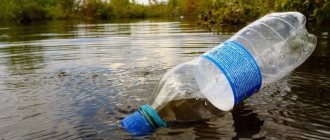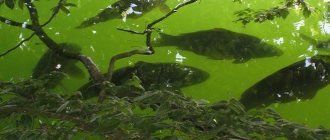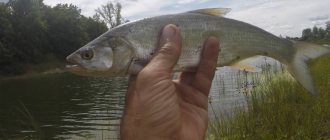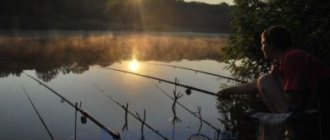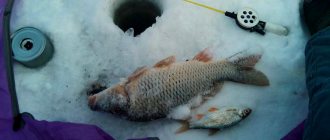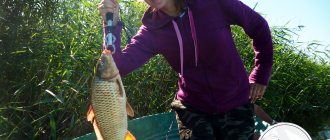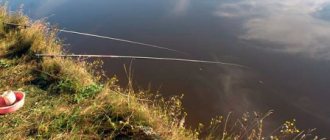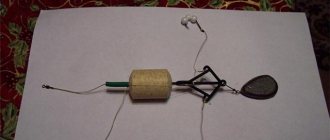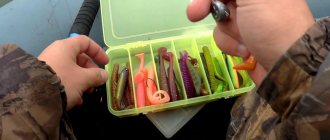Features of fishing in September
Carp or common carp (Cyprinus carpio) is a fish that belongs to the carp family. They are native to Eurasia, where they were originally considered an important food source.
Carp is one of the most common fish found in large rivers in Europe and Asia. Its distinctive features:
- golden sides;
- elongated body;
- the back is a darker shade;
- a dark spot at the base of each scale, and along the edge there is a border of dots;
- the head is large;
- retractable mouth, semi-lower, large;
- mustache above the upper lip;
- the dorsal fin is long, with a notch and one serrated ray;
- anal fin short;
- weight - up to 20 kg;
- length - up to 1 m.
The fish prefers large bodies of water with standing water. Cyprinids gather in small schools of up to 5 individuals. The ideal temperature for their life is from +23°C to +30°C. The water in which they live can be fresh or slightly salty.
The carp is omnivorous - it feeds on plants, beetles, grasshoppers, leeches, crustaceans, freshwater mollusks, minnows, bottom worms, grass, horsetail, seeds, leaves. The feeding place is near the bottom. Thanks to their varied diet, there is no shortage of carp baits.
Did you know? The Romans were the first to breed and catch carp. They contributed to the spread of fish beyond Europe to Asia. Carp only came to America in the 1800s.
What time of September is it best to catch carp?
In most cases, carp are difficult to catch. These large fish are careful, they have well-developed senses - hearing, taste, vision. But in September the carp begins preparing for winter. He needs to gain enough fat to maintain his body temperature in a cooled body of water. This period is characterized as “zhor”. It will last until the very first frost, then the fish will become inactive and it will be difficult to catch it.
Fishermen note that carp are most active in the afternoon - after lunch. This is probably due to the ambient temperature, so in the autumn morning carp are inactive, and it is worth moving the fishing time closer to noon.
Important! The higher the air temperature and the amount of sunlight in September, the more actively the carp bites.
Selecting a location
In most reservoirs, shallow water near the coastline is warmer than in the rest of the pond, so if there are cyprinids in the reservoir, then you need to look for them where it is warmer - in the side dams. Muddy or silty water is required - after all, part of the prey lives in the bottom layer. Thickets of aquatic plants become a refuge for various living creatures - fry, snails, crustaceans, and therefore carp often feeds there.
If autumn is golden, the fish will feed intensively at a depth of 2–5 meters. This happens in the following places:
- in driftwood;
- near fallen trees;
- in deep coastal waters.
What does carp bite on?
In September, the carp is actively looking for a place to winter. But he also fattens up well. At this time, he eats any bait, but most of his taste preferences depend on the weather. If it's warm and sunny, he's easy to seduce:
- dough;
- barley;
- peas, especially those soaked in milk.
Important! In good September weather, it is best to use strawberry, vanilla or fruit-scented bait. Surprisingly, carp
-
sweet tooth.
He smells the bait with cinnamon and vanilla from afar. However, the colder it is, the more often it bites on animal baits, so in October it is caught on:
- worms;
- crayfish and shrimp meat;
- meat-flavored balls.
Cyprinids also love fermented corn and boiled potatoes. Fishermen are advised to constantly experiment with baits, since specific fish also have their own taste preferences, just like people.
Here you can learn about the features of a motor drill for winter fishing.
Bait preparation technology:
- First, combine all the dry ingredients, then all the liquids.
- Knead the dough, add water, as the mass should reach a dense consistency.
- Wrap the raw materials in a plastic bag for 30 minutes. During this time, the components will combine and the mass will become plastic.
- Divide into small pieces about 1 cm in diameter. You can also roll the sausage and cut into cubes.
- Boil each piece for 2 minutes in boiling water or microwave.
- Place them on a flat surface and dry for a day.
- Store in the refrigerator in a sealed bag until fishing.
Useful video
For more information about catching carp in September, watch the video:
- In autumn the weather changes, it becomes cold. This means that carp ceases to be as active as in summer.
- With the arrival of cold weather, fish begin to look for wintering places.
- The direction of movement of fish through a reservoir in autumn is always the same.
- It is best to catch carp from the shore.
- The gear should be as sensitive as possible.
- The equipment must be thrown exactly at the location of the flock of carp.
- The fish begin to bite only after a few hours.
- You can use both plant and live bait. However, it is worth considering that the closer to winter, the more nutritious it should be.
- In autumn, carp are most active in the morning.
- Fishing locations may vary depending on the reservoir. In places where fishing is commercial, carp can be found in any place.
- The fish prefers to feed from the bottom. This should be taken into account when choosing bait and tackle.
- The gear should be durable, but at the same time inconspicuous.
What to feed
In order not to search for actively moving fish throughout the reservoir, anglers prefer to feed the fishing spot. For fish that are not too picky about their diet, the following are suitable at this time:
- steamed cereals - rice, pearl barley, rye;
- cottage cheese with sprouted wheat grains;
- cake and steamed corn;
- maggots and worms.
Did you know? Carp
-
the largest representative of cyprinids, its weight reaches 35 kg.
There are a number of requirements for bait:
- they contain components that are insoluble in water - grains;
- they should not be washed out with water, i.e. the mass should be viscous - porridge, puree, clay;
- the resulting final product should be quite large;
- An aroma that attracts fish should spread in the water around the bait.
The bait must move slowly or be stationary. Carp are not predators, so a fast moving object is not their prey, and they will not chase. Additionally, with excellent hearing and vision, they are likely to leave if the bait is too noisy or they spot an angler.
Fishing technique and tactics
Setting up the zakidushka is carried out in several stages
Equipment of the fishing site and casting of gear
To cast the gear, we will need to free up space on the shore. If you have to fish at a point with overgrown tree branches, we’ll simply secure them with guy wires to free up the sector for working with the rod and unwinding the line when casting by hand.
We put tripods for fishing rods. They can be prepared on shore or steel stands can be used. They must be installed securely. When using a classic donkey, we make grooves for each of them for fixation in the ground. Near each tackle we stick a peg for a bite alarm.
If the shore is heavily overgrown with reeds, we make a small passage for fishing out carp and throwing gear. When going on a night fishing trip, we will prepare a supply of firewood and a camp grill before dark in order to combine business with pleasure.
Bite alarm
Catching carp on a donk will require the installation of a mechanical or electronic guard. For night fishing, it is better to use a backlit alarm so as not to run along the shore in search of ringing gear. There is no need to constantly stay and monitor bites directly near the gear. The electronic device will give a sound and light signal about the bite.
Depending on the price, they can be equipped with additional functions, but, in essence, this is a waste of money for unnecessary options. For fishing in daylight, it is enough to install simple systems from lumps of earth, split twigs, or use familiar bells. The choice is individual, but installing a guard on the donkey is mandatory.
Carp bite
Bottom tackle is made on the principle of gradually swallowing hooks and releasing them into the gill slits. Therefore, we do not recommend rushing and pulling the tackle when the alarm goes off for the first time. And when a carp that has been caught and pricked pulls hard on the tackle, trying to get rid of the pain, there is no point in yawning. Smoothly pull the line and, making sure that the prey is on the hook, begin an exciting fight with a strong opponent.
Fishing
After the first carp you catch on your own, you will be convinced of the veracity of the words about its great reserve of strength. Having caught a trophy specimen, it will take you seven sweats until the prey ends up on the shore. You should not try to pull the fish by force, as you risk losing not only the trophy, but also the donk.
At first, the carp actively resists, as a result, it is important to exhaust it so that it gets tired and takes a breath of air. But before that, be sure to unwind the line a little from the reel when the fish jerks, trying to soften their destructive ability. Only after moving the trophy and exhausting it with struggle can you begin to pull it by force to the shore. But we remain careful; the carp can throw out several knees right near the shore. Here we can only hope for the help of friends and a landing net.
Donka is a passive type of fishing, but whoever claims so has probably never caught this golden beauty and taken a selfie with the catch when the fisherman looks more tired than his trophy. There are many methods of fishing, choose the one you like and go off to meet the sun and enjoy unique minutes of exciting competition with a strong opponent.
Fishing tackle for rivers and ponds
Although you can catch carp using standard spinning rods and bait, there is always gear that can make fishing more enjoyable and your efforts more fruitful.
Since carp is not a predator, the bait should be inactive. And a fishing rod holder will help with this. This accessory can be of different shapes, with adjustable legs for uneven surfaces, collapsible, with height adjustment, designed to fix several fishing rods. It will be great if the design allows you to fix the rod.
Here you can read about rattlins for ice fishing.
Float rod
The term "float rod" is usually applied to rods that are used for general fishing. The length of the carp fish mainly depends on what is more comfortable for the angler. Most of them are between 3.5 and 4.0 m long.
The main advantage of a longer rod is that you can cast it further. The larger the sector in which you cast your fishing rod, the greater your chances of catching fish. A longer one will be more accurate when throwing, and it will be better to avoid snags and other obstacles with it. But also keep in mind that a long, non-folding model will be more difficult to transport.
Important! When going to the store to buy gear, always check whether what you have chosen is suitable for catching a particular type of fish. You can't catch carp with a trout rod.
The part of the rod near the handle on which the reel is attached can be made of durable plastic, graphite or metal. It should be strong enough so that the reel does not accidentally fly into the water at the moment when you pull the carp. The most popular reels are Daiwa and Shimano.
For fishing you will need from 1 to 6 rods. Each is equipped with an inertia-free power reel, 300 meters of fishing line, hooks - No. 7 or No. 15. It is preferable to buy monofilament fishing line with a diameter of:
- 0.35 mm - for small carp up to 2 kg;
- 0.5 mm - for larger fish.
It is impossible to give uniform advice on choosing gear, since you need to take into account the capabilities of the reservoir. If only two-kilogram carp swim in it, then there is no point in taking gear for a 20-kilogram fish.
Feeder
A feeder rod is used for fishing with bait located on the bottom, without a float. And this is the best rod option for carp fishing. Changing the tips allows you to take into account the characteristics of the reservoir and the size of the fish. Its length is from 2.5 to 3.5 m. Capture is supposed to be by hooking.
Here you can read about the features of an electric drill for ice fishing.
If a regular fishing rod involves only the fishing process itself, then a feeder fishing rod combines 3 functions:
- catching;
- feeding;
- bottom exploration.
Accordingly, with such a model, the angler does not need several float rods that he uses.
Lure
Complementary food for carp consists mainly of various cereals and pieces of cereals.
Make it a rule, on every fishing trip, the first thing you do is...
How to use bait correctly:
- The ingredients should have a pronounced, but not strong aroma.
- The mushy part of the complementary food must be ground through a sieve. After such a process, food in contact with water forms turbidity, and this will attract fish.
- To prevent complementary food from falling apart when immersed in water, it must be firm and thick in consistency.
When choosing complementary foods for carp, you need to take into account the time of year, since summer treats are slightly different from winter ones. Any edible products that can be found at home are suitable as summer complementary foods.
Well, to better attract him, additional household items will be needed. feed sold at the poultry market:
- cake;
- barley;
- compound feed;
Bait in summer may not contain animal feed (worms, bloodworms).
The following products are suitable for preparing delicacies for carp:
- corn;
- pearl barley;
- peas;
- semolina;
- dough;
- potato;
- sunflower oil;
- roasted seeds;
- dog food;
- powdered milk;
- cereals;
- cookies, crackers;
In winter, the fish starves and tries to saturate its body with nutrients as much as possible, so almost all products can be left from the summer diet, but at the same time, sweet additives must be excluded.
Animal bait is suitable for coaxing carp. They should prevail in the total amount of all bait. Fish respond well to bloodworms, worms, and maggots, since this is the protein that carp needs in winter.
Ready-made baits are sold in fishing stores, but they cost a lot of money, and as a rule, you need a lot of them for one fishing trip.
In this case, making your own baits is a cheaper option. To do this, you need to mix several different ingredients.
The recommendation from experienced fishermen is to constantly experiment to create the ideal bait for carp.
As already mentioned, in the summer, fish actively react to sweet odors, so it is necessary to add various additives and flavorings in the form of vanilla, chocolate, honey, anise and others to complementary foods.
Effective recipes
Recipe one:
- This is the simplest and most effective complementary food, which is prepared from peas and boiled pearl barley. These products are considered basic, and additives and flavoring agents are already added to them. This type of bait is suitable for filling the feeder and feeding the fishing area.
- Yellow peas are used for cooking. Before boiling it, it must be steeped in water for 24 hours. The peas are cooked over low heat for 1.5-2 hours. If peas are to be used as bait, it is better not to overcook them. If only for bait, then it can be brought to a puree-like consistency.
- The barley should be cooked for about an hour over low heat. Once ready, the container with the porridge must be wrapped in a towel so that the pearl barley reaches it.
- Then it’s a matter of small things, the finished ingredients are mixed. You can add feed, flour, and cookies to this mixture. For aroma, hemp or sunflower oil.
- In terms of consistency, the bait is viscous and holds well in a feeder or casting balls instead of catching carp.
Recipe two:
- The composition of this complementary food includes: cake, millet, wheat, semolina, corn grits, peas and pearl barley.
- Millet, wheat, pearl barley, peas and corn grits are poured into boiling water. The porridge should be cooked until it is softened. During cooking, the mixture must be stirred occasionally to prevent it from burning. When the porridge is ready, semolina and cake are added to it. Mix everything and leave to cook over low heat for 15 minutes.
- In addition to the puree-like composition, such bait also contains small fractions of grain, which will attract fish. To improve the effect, it is recommended to add flavoring agents.
Recipe three:
This recipe is suitable for winter carp fishing.
Required ingredients:
- regular corn;
- dog food;
- animal bait;
- powdered milk;
The corn should stand soaked for 2 days. After this, it must be dried and ground together with the feed. Powdered milk and unrefined sunflower oil are added to the mixture.
The pulp is filled with worms, maggots and bloodworms. This bait is very nutritious for carp. In winter, he actively comes to the place where this treat is located.
Despite the fact that the carp loves to have a good snack, a lot of complementary foods should not be used. For a feeding area, it is enough to throw 3-4 small balls. If a lot of complementary food is used, but there is no bite, it will turn sour and this smell will scare away the fish. Feeders should be filled so that they weigh 45-60 grams.
Fishing technique
Finding carp is not as difficult as catching it. Fishing rods must be fixed motionless near the shoreline so as not to interfere with swallowing the bait, so you need to know a number of nuances for the bite to be successful:
- You need to start fishing early in the morning. Biting spots can be seen by the way air bubbles rise to the surface - a sign that large fish are feeding. And since carp feed near the bottom, fishing should be done with bait lying on the bottom.
- To install the fishing rod, choose a place with standing water, be careful, as the fish will move away from the bite site when there are extraneous sounds or movements.
- The carp quickly takes the bait, so it’s difficult not to notice the bite. When pulling out a fish, lead it to the landing net to make it easier to remove.
- After you get the fish, you need to feed the fishing point in order to have a chance to catch another specimen.
Catching carp is an exciting activity, and the fish itself has excellent taste. The secret to success will be the right gear and the ability to wait. Fish in a way that suits you and get a lot of positive impressions from the process.
Catching carp in autumn
Like any other fish, in anticipation of wintering, the carp begins to feed intensively and accumulate the necessary energy for the winter. At this time, any bait and fishing gear will be suitable. Catching carp in the fall can also be very exciting.
With the arrival of cold weather, the fish leave shallow water, move closer to wintering holes, stop near steep banks and in pools with a hard clay bottom. At this time, it bites better in calm weather, tries to stick to feeding areas, but in the rain it sinks to the bottom and does not respond to food. At this time, knowledge of the bottom topography will be very helpful, since the fish will be on or near the holes. An echo sounder will be very helpful with this. By the way, it can also be very helpful in detecting the carp itself, since, due to its impressive size, it will be displayed there.
It is also worth noting that the parking places for carp fish are the same every year, and having successfully fished one year, you can safely come to the same place the next. Having caught on a hook, the carp will not give up so easily; when caught, it makes long jerks, the force exceeding its weight by 4 times. And the upper fin, especially in large specimens, is sharp and jagged, capable of cutting not only the fishing line, but also the net.
If the bite is not active, then you can lure the fish by throwing bait. Just keep in mind that due to low water temperatures, the activity of aquatic inhabitants decreases and so does the appetite, so it is necessary to throw porridge (or other bait) 2 times less than in summer.
